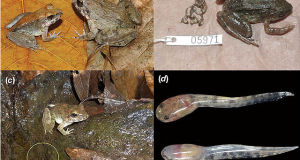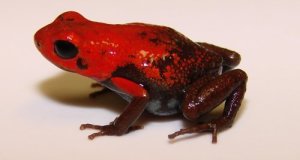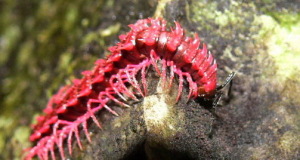I remember well my shock when the news concerning temperature dependant sex determination (TDSD) among reptiles first broke. Imagine…a turtle or crocodile egg can develop as either a male or female, depending upon the incubation temperature! Well, it now seems that at least one species of lizard, the three-lined skink (Bassiana duperreyi), complicates matters even further.
Egg Size and Sex
 Writing in the June, 2009 issue of Current Biology, University of Sydney biologists have revealed that large skink eggs develop into females, while small eggs become males. Furthermore, removing yolk from a large egg resulted in a male hatchling, despite the fact that female genes were present; adding yolk to a small egg over-rode the effect of the male genes already in the egg, producing instead a female.
Writing in the June, 2009 issue of Current Biology, University of Sydney biologists have revealed that large skink eggs develop into females, while small eggs become males. Furthermore, removing yolk from a large egg resulted in a male hatchling, despite the fact that female genes were present; adding yolk to a small egg over-rode the effect of the male genes already in the egg, producing instead a female.
Temperature and Sex
Extreme nest temperatures, it seems, can also affect the hatchlings’ sex, regardless of its genetic makeup, resulting in xx chromosome males (males are usually xy) and xy females (females are typically xx).
Survival and Conservation Implications
The question that begs answering, of course, is why has this lizard evolved such a unique and complicated reproductive strategy? Researchers are now looking into its ecology to determine the answer.
Understanding such matters has greatly assisted those working to conserve reptiles and amphibians. Knowing the parameters of TDSD has allowed us to pick and choose the sexes of highly endangered species being bred in zoos, so that a favorable sex ratio can be maintained.
 Of course, there were some problems early on. I was working with green sea turtle head-start programs in Costa Rica when TDSD first came to light. The organization I was with had been gathering sea turtle eggs for 30 years, incubating them, and then releasing the young when they had grown past the vulnerable stage. Great in theory…but by using a single incubation temperature, we may have produced only female green turtles for the entire 3 decades!
Of course, there were some problems early on. I was working with green sea turtle head-start programs in Costa Rica when TDSD first came to light. The organization I was with had been gathering sea turtle eggs for 30 years, incubating them, and then releasing the young when they had grown past the vulnerable stage. Great in theory…but by using a single incubation temperature, we may have produced only female green turtles for the entire 3 decades!
Further Reading
You can read more about the natural history of the three-lined skink and its relatives at http://www.jcvi.org/reptiles/species.php?genus=Bassiana&species=duperreyi.
 That Reptile Blog – Reptile, Amphibian and Exotic Pet Care and Information
That Reptile Blog – Reptile, Amphibian and Exotic Pet Care and Information



